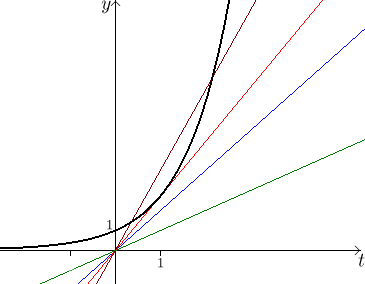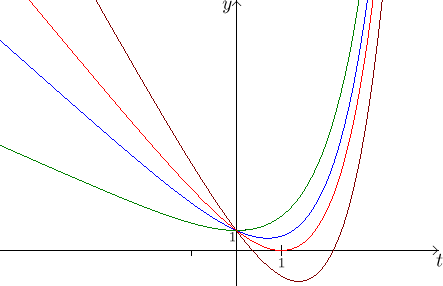Problem: Prove that for all numbers t ≥ 0 we have

Solution: Denote
f (t) = et
and
g(t) = 2t. We need to prove that
f ≥ g on the interval
I = [0,∞).
Since algebraic reasoning seems out of question, we will try to
use a theoretical approach, namely using derivative as described for
instance
here in Methods
Survey - MVT.
First we check on how these two functions compare at the left endpoint of
I: f (0) = 1 and
g(0) = 0. Thus
f (0) > g(0), that's a good start. Now
we compare their derivatives at the interior of I. We have
f ′(t) = et
and g′(t) = 2. If f ′ were
always (for positive t) at least as large as g′, then the
function f would start larger at the left end of I and grow at
least as fast as g, thus it would be larger on the whole I.
Unfortunately, this is not true, et is less than 2 for
small positive t. Thus the function g grows faster at the
beginning of the interval I, so it is quite possible that is catches
up with f and even passes it before f starts growing faster
again. Thus this approach failed.
Remark: Consider the function h(t) = t.
Again we have f (0) > h(0), but this
time also f ′ > h′ for
t > 0, since
h′(t) = 1. Thus the above algorithm does
work now to prove that in fact
et > t on the interval I.
Note that the exponential is always positive, so this inequality
is trivially true also for negative t. Consequently,
et > t
for all real t. Similarly, we also have
et > 2t for
negative t.
This brings us back to our problem.
What do we do with the unpleasant 2 in g? Note that the question
above is really a question of how fast the line 2t
grows, whether it manages to intersect the graph of the exponential or not.
We saw that the line given by t does not, obviously the coefficient
(slope) 1 is not large enough. If we start increasing this slope, then the
line starts growing faster, eventually first touching the exponential and
then (with still larger slope) crossing it.

(The line given by t is marked in green. To make the picture nicer we
did not use the same scale on horizontal and vertical axes.) Where does the
given line 2t fit in? To see that it is better to change the setting.
We actually proved above that the function
et − t is positive on
I (even everywhere), similarly it would be enough to prove that the
difference
d(t) = et − 2t
is positive (or zero) everywhere, in particular on I. How can we do
such a thing? Quite easily, we find the minimum of d and then check
whether it is negative or not.
For that we have a standard
algorithm.
Note that at both ends (infinity and minus infinity) the function
et − 2t grows to
infinity, thus its global minimum (or possibly more of them) is to be found
somewhere in the middle, at a critical point. From the derivative
d′(t) = et − 2
we get one such point, t = ln(2), so the value
of the global minimum is
d(ln(2)) = eln(2) − 2ln(2) = 2 − 2ln(2) = 2[1 − ln(2)] > 0.
This proves that d is always positive, therefore also
et > 2t for
all t.
Bonus problem: We saw that the line given by 2t does not
overtake the exponential, by the way, it is marked blue in the above
picture. From the picture it also seems that still faster lines could make
it. Where is the dividing line? Precisely, for what value A does the
line given by y = A⋅t
touch the exponential?
We again use the approach via minimum. Let's make a picture corresponding to
this point of view. We are actually looking at the curves below representing
the differences between the exponential and various straight lines given by
A⋅t, and we would like to know which of them has its
minimum equal to zero.

We proceed as before. First we consider the function (with parameter
A) given by
d(t) = et − At.
Its derivative is
d′(t) = et − A,
solving the equation d′(t) = 0 we get
the only critical point
t = ln(A). It shows where the global
minimum of d is attained, its value then is
d(ln(A)) = eln(A) − A⋅ln(A) = A − A⋅ln(A) = A⋅(1 − ln(A)).
We see that this minimum is equal to zero exactly if
ln(A) = 1, that is, for
A = e.
Conclusion: The line given by
y = e⋅t
touches the graph of the exponential. For
0 < A < e the lines
y = A⋅t lie below the
exponential, for
A > e these lines cross the graph of
the exponential at two points.
Next problem
Back to Solved Problems -
MVT
![]()

